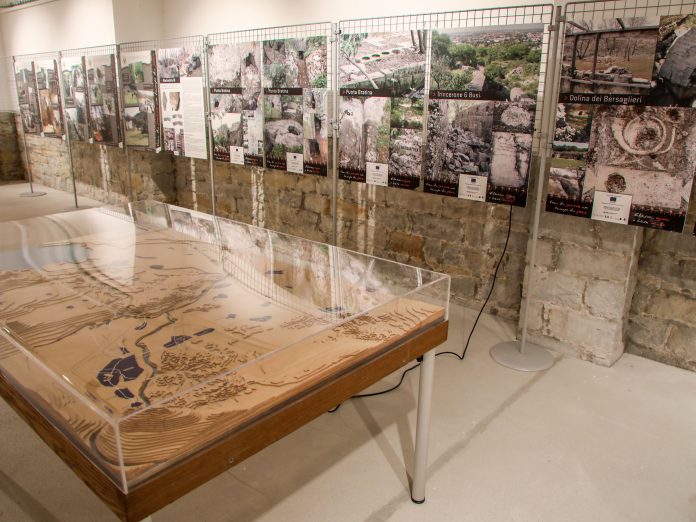by InTrieste
An exhibition tracing the journey of a storied stone, which has sculpted both landscape and history from Ljubljana to Trieste, opened recently at the historic Warehouse 26 in Porto Vecchio-Porto Vivo. The exhibition, titled “From Ljubljana to Trieste: The Stone of Aurisina, the Karst, and Istria in Italy and the World,” will be on view through July 14, offering visitors a free exploration of the material that has profoundly influenced architecture and art across centuries.
The display is a collaborative effort, co-organized by the Municipality of Trieste and the Ermada Group “Flavio Vidonis,” with support from the Autonomous Region of Friuli Venezia Giulia. The comprehensive exhibit spans multiple sections in two halls, presenting a tactile journey through the rich culture of stone. Visitors can immerse themselves in its historical and artistic significance, guided by photographs, projects, models, and installations.
The narrative begins with the biography of Gustav Tönnies, an industrialist whose entrepreneurial ventures in the 19th century left an indelible mark on the region. Born in 1814 in Stralsund, Pomerania, Tönnies’ journey spanned across Sweden, Norway, France, Switzerland, and Russia before he settled under the Austrian monarchy. He emerged as a pivotal figure in Carniola, driving economic and industrial growth during his era.
The exhibition’s ambition extends beyond mere historical recounting. It aims to illuminate the significant role Karst and Istrian stone played in regional development. Extracted from local quarries, this stone’s architectural and artistic applications can be appreciated through various forms presented in the exhibition.
Trieste’s history, marked by key dates like its transition to Austrian rule in 1383, the free port status in 1719, and a direct connection to Vienna in 1849, is deeply intertwined with the stone’s legacy. The Southern Railway Vienna-Trieste, a monumental achievement, transformed Trieste into an international financial hub and the principal port of the eastern Mediterranean, facilitating widespread distribution of Karst stone.
A parallel historical development occurred in Ljubljana, which, with its own railway connection to Vienna and Trieste, rose in prominence, further solidified by the post-1895 earthquake reconstruction. The stone from this region, shipped globally thanks to the new railway, became a fashionable material in the 19th century, used in an array of public and private edifices.
Gustav Tönnies and his descendants were instrumental in this development. Their contributions to the stone industry helped integrate the region into the broader spectrum of industrialization. Today, the renewed interest in Karst stone underscores its enduring legacy in both restoration and modern construction.
The exhibition is complemented by a series of guided tours, cultural discussions, and workshops, enhancing the visitor experience with deeper insights into the stone’s history and applications. Highlights of the event schedule include conferences on the historical perspectives of stone working, guided tours of the exhibition and local historical sites, and presentations of related artistic projects.
Event Highlights:
Thursday, May 23, 5:30 PM
- Photographing the City: A meeting with photographer Lorenzo Parenzan.
Friday, May 24, 11:00 AM
- Karst Stone: Historical insights into stone working and the contributions of the Gustav Tönnies family, featuring speakers like Jasmina Rijavec and Stojan Jakopič.
Saturday, May 25, 11:00 AM
- Guided tour of the exhibition.
Thursday, May 30, 10:30 AM
- Memory of the City of Carrara: A conference moderated by Francesca Bianchi.
Friday, May 31, 5:30 PM
- Remembrance Park: A discussion on inclusive memory, featuring members of the “Parleranno le Pietre” Association.
Saturday, June 1, 11:00 AM
- Karst Stone: A detailed look at stone’s role in architecture and art, with speakers like Prof. Janez Koželj and geologist Jasmina Rijavec.
Saturday, June 1, 5:30 PM
- Presentation of the “Arcani di Pietra” catalog and exhibition by artist Claudia Raza.
The event series also includes excursions to significant local sites, such as the Mithraeum in Duino Aurisina and the historical ruins of Aquileia, providing participants with a full-spectrum understanding of the region’s geological and cultural heritage.
As the exhibition underscores, the legacy of Karst and Istrian stone is not just a historical footnote but a living, breathing part of modern architecture and art, continuously shaping the present as it did the past.





























